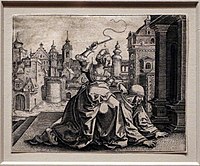Little Masters
The Little Masters ("Kleinmeister" in
The term Kleinmeister was used of the Nuremberg Little Masters as early as 1679, by Joachim von Sandrart, and has been applied to other groups of artists, from the genre masters of the Dutch Golden Age to a group of 6th-century BC Ancient Greek vase-painters.
Artists
The earliest artist to make very small intricate engravings was Altdorfer in 1506–7, probably following the example of Italian niello prints,[3] although their size was in fact no smaller than the bottom end of the very cheap devotional woodcuts made throughout the 15th century. However Altdorfer's printmaking developed in different directions, though he continued to produce some small engravings until the 1520s, by which time the style had been taken up by the Nuremberg artists, the Beham brothers and their close friend Pencz.[4]
Hans Sebald Beham and Pencz continued to produce engravings until shortly before their deaths in 1550, which effectively ended the style; Barthel Beham had died in 1540. Barthel is generally considered the most inventive of the Nuremberg trio, but his brother Sebald was much more productive, with perhaps the finest technique, and also copied some of Barthel's prints after his death. Aldegrever was a convinced
Their engraving style was based on the work of
Compared to their contemporaries, devotional subjects are notably absent in the work of the Nuremberg artists, who were all expelled from the city for their religious views in 1525 – an episode that still remains rather unclear. Their prints were very widely disseminated, and both drawn copies and examples of the originals have been found in albums from
Minor members of the group were
-
Albrecht Altdorfer, Hercules and a Muse, 7.8 × 4.5 cm.
-
Barthel Beham, Genius on a Globe Floating in the Air, engraving, 1520, 5.7 × 3.6 cm, perhaps a parody of Dürer's Nemesis.
-
Georg Pencz, Wrath (Ira), from a set of The Seven Vices, 8.4 × 5.4 cm
-
Heinrich Aldegrever, Dancing Couple from The Small Wedding Dancers set, 5.3 × 3.8 cm
-
Hans Brosamer, Phyllis and Aristotle, c. 1545
Notes
- ISBN 0-7141-2608-X
- ^ Mayor, p. 315, and Russell, p. 11 and passim throughout
- ^ Mayor, p. 315
- ^ Bartrum, pp. 12 and 115
- ^ The full set with catalogue details
- ^ If he is the "Knecht" (boy) "Jörg" recorded as marrying Dürer's maid. Hind, p. 85
- ^ Mayor, pp. 315–17
- ^ Bartrum, p. 12
- ^ An example of a stoneware jug is at Bartrum, pp. 112–13
- ^ Hind, p. 85
- ^ Landau & Parshall, pp. 332 and 356
References
- ISBN 0-7141-2604-7
- ISBN 0-486-20954-7
- ISBN 0-691-00326-2
- David Landau & Peter Parshall, The Renaissance Print, Yale, 1996, ISBN 0-300-06883-2
- H. Diane Russell, Eva/Ave; Women in Renaissance and Baroque Prints, National Gallery of Art, Washington, 1990, ISBN 1-55861-039-1
Further reading
- Goddard, Stephen H. (ed); The World in Miniature: Engravings by the German Little Masters, 1500-1550, 1988, Spencer Museum of Art University of Kansas, ISBN 978-0-913689-26-4
- Möseneder, Karl (ed); Zwischen Dürer und Raffael. Graphikserien Nürnberger Kleinmeister, Petersberg 2010, ISBN 978-3-86568-571-1
- Martin Knauer, Dürers unfolgsame Erben. Bildstrategien in den Kupferstichen der deutschen Kleinmeister, Petersberg 2013 ISBN 978-3-86568-650-3





